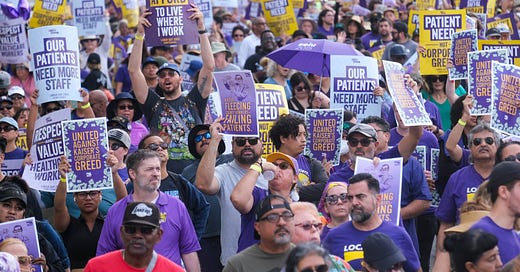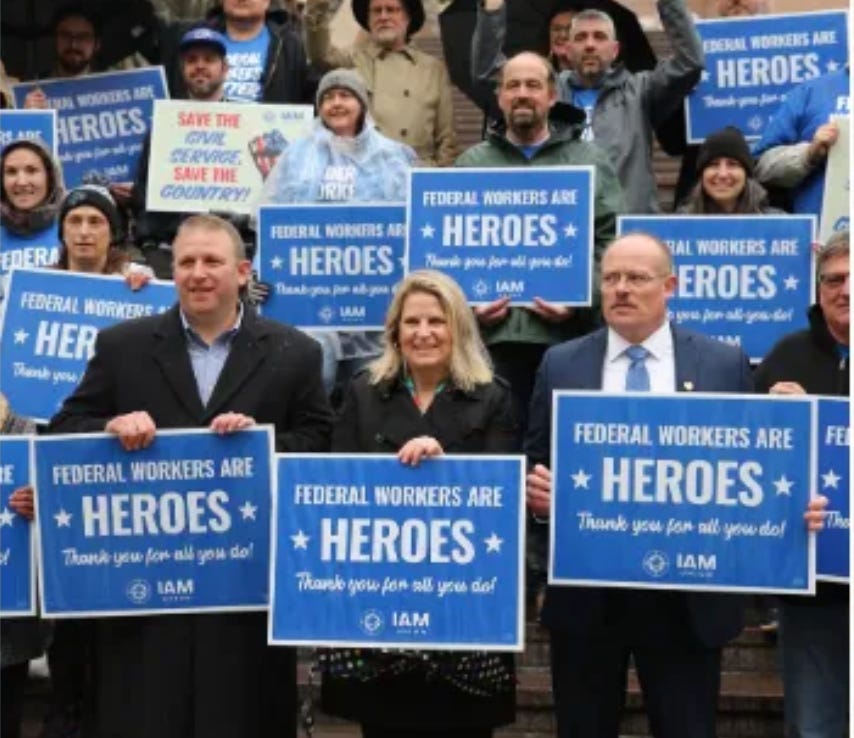The Trump Regime’s War on Working People
How Unions are Resisting Authoritarian Attacks on Workers’ Rights—and Why It Matters for Everyone
Over the first hundred days of Donald Trump’s regime, observers and analysts rightly highlighted his administration’s alarming attacks on fundamental democratic institutions—the judiciary, law firms, universities, philanthropies, non-profit groups, and the media. These assaults were not only dangerous individually but crucially significant as components of authoritarian consolidation.
Yet, amid these well-documented threats, a similarly profound yet largely overlooked attack unfolded: Trump’s systematic assault on unions and working people. This assault, executed alongside allies like Elon Musk, demonstrates once again the fundamental truth articulated decades ago by Supreme Court Justice Louis Brandeis:
“We may have democracy, or we may have wealth concentrated in the hands of a few, but we cannot have both.”
Historically, unions have served as powerful bulwarks against authoritarianism, not just for those directly represented but for democratic society at large. Unions strengthen democracy by fostering shared prosperity and providing a robust mechanism for collective action against oligarchic dominance. Trump’s actions against labor mirror those of Ronald Reagan, who, by decisively firing over 11,000 striking air traffic controllers in the early 1980s, not only disciplined unions but broadcast a message nationwide that emboldened corporate America to escalate anti-union activities. Reagan also weakened the National Labor Relations Board (NLRB), ensuring it would favor employer interests and erode labor protections. Trump’s administration followed this blueprint precisely, manipulating governmental power to diminish union influence aggressively.
The context today differs in specifics, but both periods mark critical transitions. Reagan’s era saw globalization and financialization reshaping the economy; Trump’s administration intersects with the advent of artificial intelligence, promising vast corporate transformations. Elon Musk’s strategic mass firings at Twitter, aimed at creating a frictionless transition to AI-driven workplaces, serve as a clear model for the broader privatization and corporate restructuring envisioned by Trump. This approach isn’t limited to corporations; it directly implicates government institutions, systematically undermining them to justify and expedite privatization. This vision for the future dangerously threatens workplace stability and the democratic accountability inherent in public service.
In merely a hundred days, Trump orchestrated a comprehensive dismantling of union protections and civil service stability. His executive orders stripped collective bargaining rights from over a million federal workers, signaling to employers nationwide that union rights were vulnerable. Trump strategically replaced key independent agency officials committed to protecting workers—such as Gwynne Wilcox from the NLRB and Susan Tsui Grundmann from the Federal Labor Relations Authority (FLRA)—with allies more sympathetic to employers. His nomination of a partner from the notoriously anti-union law firm Morgan Lewis as NLRB General Counsel reinforced this hostile takeover.
Trump’s destructive trajectory included targeted attacks on independent agencies designed to safeguard civil rights and labor standards. The dismissals from the Merit Systems Protection Board (MSPB) and Equal Employment Opportunity Commission (EEOC) compromised vital protections against unfair employment practices and workplace discrimination. Trump’s administration didn’t merely fire personnel; it sought to neuter the very institutions responsible for mediating labor disputes and upholding employment standards, significantly weakening the Federal Mediation and Conciliation Service.
The administration’s systemic assault has extended far beyond administrative reshuffling. Trump aggressively undermined wages and worker safety, eliminating essential training and apprenticeship programs and upending protections designed to ensure equity and dignity in workplaces. Trump’s rollback of executive orders mandating fair wages for federal contractors and protections against employee misclassification exacerbated profound economic inequalities. Simultaneously, his administration drastically weakened safety agencies like the National Institute for Occupational Safety and Health (NIOSH), endangering miners, healthcare workers, and other laborers in high-risk sectors.
The Trump administration’s hostility tore into civil service through mass firings and hiring freezes, exacerbating governmental dysfunction. Agencies like USAID, the Consumer Financial Protection Bureau, and Voice of America faced intentional assault, severely impairing public services domestically and internationally. By reclassifying career civil servants as political appointees, Trump stripped the civil service of protections designed to ensure impartiality and expertise, thereby undermining public trust and effectiveness. Policies that humiliated workers, such as mandatory in-person work directives and invasive performance reporting requirements, further demoralized an already beleaguered workforce.
The regime also targeted protections against workplace discrimination, systematically denying regulatory protections that had fostered diversity, equity, and inclusion. Trump’s reversal of protections for LGBTQI+ individuals, along with his aggressive rollback of anti-discrimination policies in federal contracting and employment, undermined decades of progress towards equitable workplaces.
However, Trump’s aggressive anti-labor actions have not gone uncontested. Unions have emerged as frontline defenders of democratic and workplace rights, mounting vigorous legal challenges to Trump’s overreach. Organizations like the AFL-CIO, led by President Liz Shuler, have actively mobilized against these attacks, organizing nationwide protests and town halls to galvanize public support. Notably, even traditionally conservative union sectors like the Building Trades have vocally opposed Trump’s draconian measures, highlighting collective bargaining as one of the few remaining pathways to the middle class.
These legal battles, such as National Treasury Employees Union v. Trump and American Federation of Government Employees v. Trump, represent critical efforts to preserve democratic accountability. They confront Trump’s attempts to unilaterally dismantle collective bargaining agreements, illegally terminate probationary employees, and exploit executive power to privatize essential public functions.
In other words, the battle unfolding within America’s labor landscape is about far more than workplace rights—it is a struggle for the survival of democracy itself. Trump’s orchestrated attack on unions and civil service institutions exposes a deliberate strategy aimed at consolidating authoritarian power by eroding the economic and social foundations upon which democracy rests. Recognizing and resisting these attacks, as previous generations have, as increasing numbers of people are doing today, remains essential to safeguarding democratic governance and shared prosperity.
Michael Podhorzer is former political director of the AFL-CIO, senior fellow at the Center for American Progress and founder of the Analyst Institute, Research Collaborative. He publishes Weekend Reading.








But wait, the head of UAW says tariffs are good because they'll bring back manufacturing jobs. They might, but they aren't going to MI, OH, WI or PA where unions are strong and have a history of making increased wages and benefits a priority. Manufacturers didn't leave America, Americans left products manufactured in America.
Remember when Volkswagons and Japanese made cars became so popular in the late 1960s and 1970s. It was because they were quality cars and inexpensive compared to American models. In the 1980s Ford used to say "Quality is Job One". Not anymore. Today car companies figure in the recalls when issuing a new model. If manufacturing comes back to the US, it's going to take years of tariffs and the American people paying. In the mean time the economy will go into recession after recession, just as it did between the late 1800's to the late 1920s.
I had not connected this undermining of worker rights to the imminent introduction of AI—one of the billionaire class objectives. It’s chilling. And the AI I’ve encountered so far is next to worthless in getting problems solved. I wonder what happens to our brains (and usefulness as citizens) when we are totally dependent on tech for information. I long ago lost the ability (or incentive) to remember phone numbers. Ketamine trances for all?